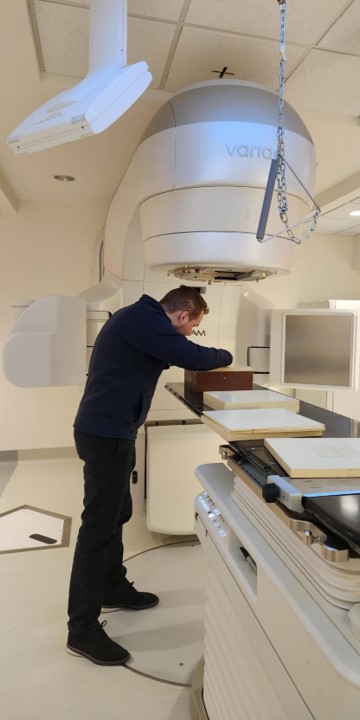Residency Curriculum
The Therapeutic Medical Physics Residency Program is a CAMPEP-accredited two-year program with the goal of training clinically competent medical physicists for independent practice in medical physics and radiation therapy. Our program places a strong emphasis on fostering clinical excellence and professional development, ensuring residents acquire the essential skills and knowledge needed for successful careers.
Our two-year program is a balance of theoretical knowledge, clinical experience, and professional development. Our curriculum is designed to provide a comprehensive and structured educational experience for medical physics residents during their 24 months of training. We have developed a comprehensive curriculum to help residents develop the knowledge, skills, and professionalism required to become board-certified medical physicists.
Year One Rotation Schedule
In the first-year medical physics residency, residents focus on building a strong foundation in medical physics. This first year involves close introductory work with medical physicists and dosimetrists. Residents rotate thru the first five clinical rotations (listed below) to understand the fundamental principles and techniques in medical physics. Residents learn to perform critical tasks and participate in patient care under the guidance of their preceptors and senior resident.
Residents receive a rotation schedule that provides an overview of each clinical rotation, including rotation duration, learning objectives, evaluation criteria, and recommended reading materials.
Residents are regularly evaluated to ensure they meet the program's competency requirements. At the end of each rotation residents participate in mock oral exams with their preceptors and other medical physics faculty.
- Dosimetry
- Linac Annual Quality Assurance
- Quality Assurance and Plan Review
- Radiation Safety
- Stereotactic Radiosurgery/Stereotactic Body Radiotherapy
Year Two Rotation Schedule
In the second-year medical physics residency, residents focus on advancing their clinical skills, gaining the competences needed to practice independently and preparing for board certification. Residents are provided with autonomy to develop independent thinking and problem-solving skills. Residents rotate thru their remaining clinical rotations (listed below), repeating some rotations completed during the first 12 months of training. Residents take on more challenging tasks and are assigned independent clinical tasks including physicist of the day clinical duty. Residents also provide support and mentorship to first year residents, sharing their experiences and knowledge, to help with a smooth transition into the program.
Residents are provided with protected time to prepare for the American Board of Radiology Part 2 computer-based exam.
Residents are regularly evaluated to ensure they meet the program's competency requirements. At the end of each rotation residents will participate in mock oral exams with their preceptors and other medical physics faculty. During the second year of training these exams are aimed at preparing residents for the American Board of Radiology Part 3 Oral Certifying Exam.
- Acceptance & Commissioning
- Brachytherapy
- Linac Annual Quality Assurance
- Radiation Shielding
- Special Procedures: Total Body Irradiation
- Special Procedures: Total Skin Electron Therapy
- Therapeutic Imaging
- Tomotherapy
Residents are required to attend and participate in:
- Department Chart Rounds
- Medical Physics Course
- Morbidity and Mortality Conference
- Physics Didactics
- Physics Journal Club
- Radiation Biology Course
Residents are encouraged to attend:
- Department Grand Rounds
- Tumor Boards
- Graduate Medical Physics Journal Club
- Graduate Medical Physics Advanced Imaging Course
Residents are also required to instruct in a lecture or practicum setting to the graduate students and/or medical residents.
The Therapeutic Medical Physics Residency Program does not have a research requirement but residents are strongly encouraged to develop this skillset through clinical implementation projects which require literature review, experimentation, and documentation. Residents are provided with up to four months to work on research or clinical projects.
Example of such projects include:
- Beam modelling and validation testing of VersaHD in Eclipse prior to FDA release
- Modelling and validation of a couch top designed to create compatibility between the Hexapod table and the Calypso tracking system
